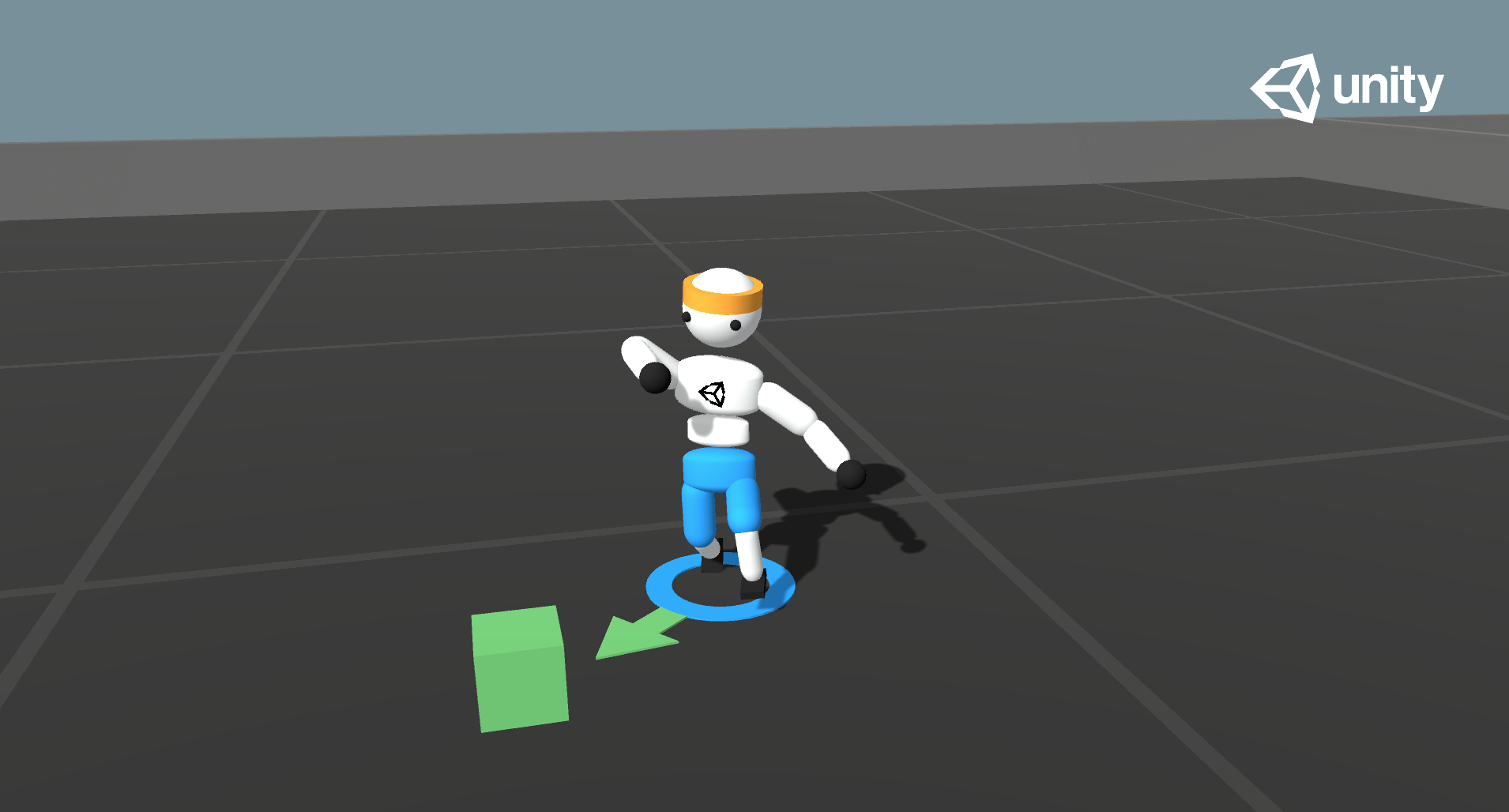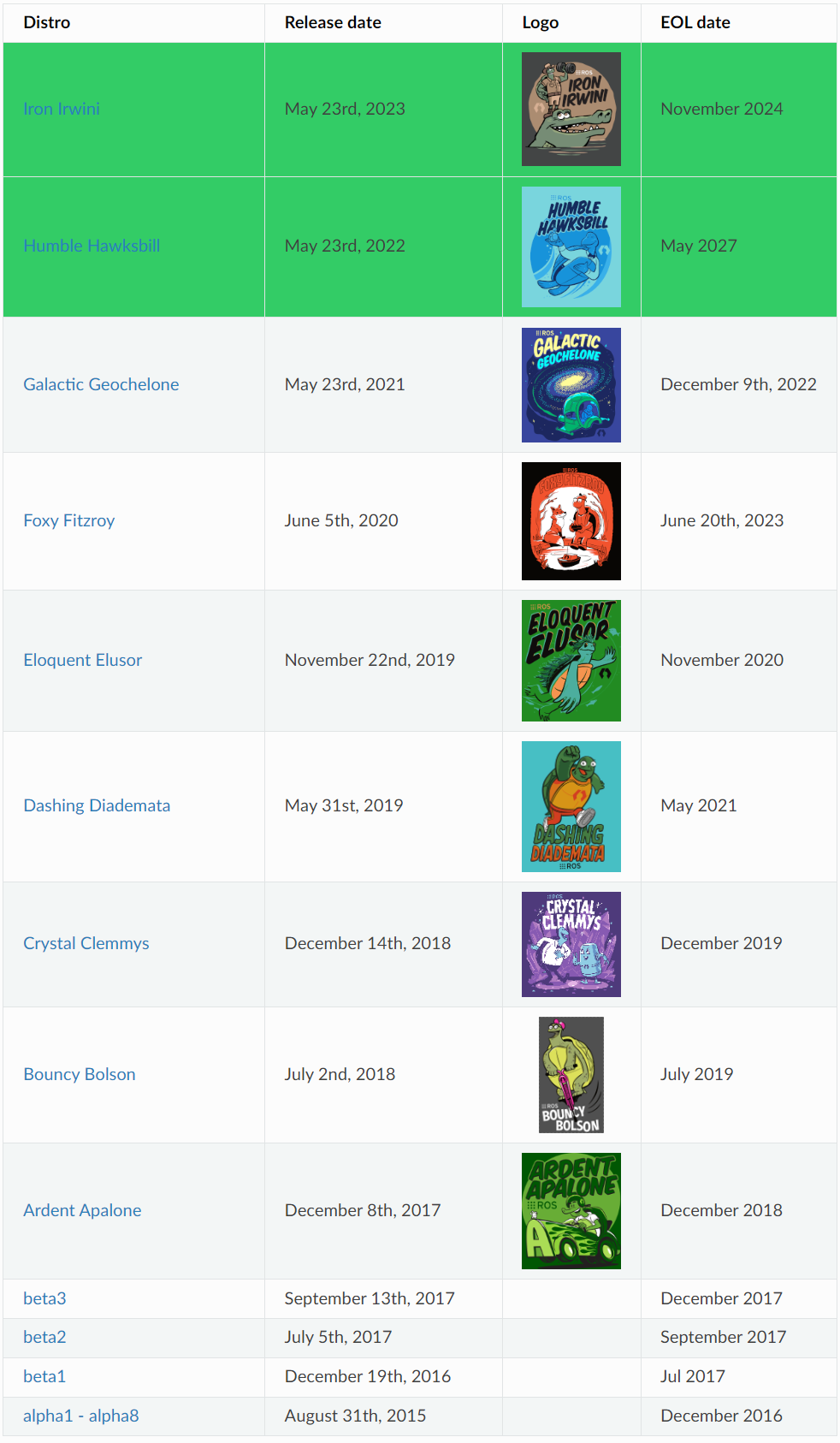
ML-Agents案例之机器人学走路
本案例源自ML-Agents官方的示例,Github地址:https://github.com/Unity-Technologies/ml-agents,本文是详细的配套讲解。本文基于我前面发的两篇文章,需要对ML-Agents有一定的了解,详情请见:Unity强化学习之ML-Agents的使用、ML-Agents命令及配置大全。我前面的相关文章有:ML-Agents案例之CrawlerML-Ag
本案例源自ML-Agents官方的示例,Github地址:https://github.com/Unity-Technologies/ml-agents,本文是详细的配套讲解。
本文基于我前面发的两篇文章,需要对ML-Agents有一定的了解,详情请见:Unity强化学习之ML-Agents的使用、ML-Agents命令及配置大全。
我前面的相关文章有:

环境说明
在阅读本文之前,可以参考ML-Agents案例之Crawler、ML-Agents案例之蠕虫这两个案例。它们的目标都是一致的:吃掉绿色的方块,并且都是仿生机器人,区别是仿生的对象不一样,之前是仿爬虫和蠕虫,这一次是直接仿人。因此,本案例是之前两个案例的高配版,机器人的关节要比以往多得多,这将导致输入和输出维度上的急剧增加,这对训练来说是一项巨大的挑战,导致找到一个好的策略称为一项艰难的任务。
现在我们看看机器人的构造:


可以看到,相比于现实中的人,Unity中的机器人已经在关节上做到尽量简化了,例如:锁死了手腕的关节,没有手指脚趾,脊椎当成一个关节等。但是剩余的关节数目仍然是一个比爬虫大得多的数目。
我们查看其物体列表,发现整个人以臀部作为所有部位的父物体。然后臀部上挂的子物体有左腿、右腿、躯干,它们的关节链接的都是臀部。如下腰部连接臀部:


可以看到腰部的关节的x,y,z三个轴都是可以转动的,因为人的腰在生理构造上是既可以前后倾,也能左右倾,还能左右扭腰。我们可以通过Edit Angular Limits可视化修改其可以转动的幅度。
左右腿同理,连接臀部,但是自由度z轴旋转被锁定,这是因为人腿部并不能做到像腰一样左右扭动。

每一条腿除了和臀部连接的关节外,还有膝盖和脚踝两个关节。
膝盖只有一个x轴能够旋转,即一个自由度,连接的是大腿部。


同样的,脚踝三个轴都能旋转,连接的是小腿部。


现在我们再来看看躯干部分的各个关节,整个躯干的父物体是腹部。
首先是脊椎,也是胸部的关节,连接的是腹部,x,y,z轴皆可旋转。


然后链接胸部的有三个部位,分别是左手,右手,头部。
先看看头部,头部是两个轴的自由度。


然后是手部,左手右手一样,胳膊上有一个关节,两个轴的自由度(个人认为应该有三个轴的自由度),连接胸部。手肘上有一个关节,一个自由度,连接上臂。




到此为止,上面讲解的就是我们接下来要控制的关节了。同样,想要控制各个关节的运动,我们需要在智能体上挂载一个JointDriveController.cs的脚本,这个脚本不会自己运作,只有在别的脚本的调用下才会起作用。关于这个脚本的代码说明参考ML-Agents案例之Crawler。
我们在进行深度强化学习训练时,智能体接收的状态输入为:目标速度与身体平均速度的距离,一维。指向方块坐标下的身体速度和目标速度,六维。头部方向到目标方向的旋转,四维。整个身体面朝方向到目标方向的旋转,四维。目标方块相对于智能体的坐标,三维。每节躯体的移动速度、角速度、是否接触地面、相对于臀部的位置,16 * 10维。每个关节的力度、局部坐标的旋转,13 * 5维。一共是243维。
动作输出:我们一共有13个关节需要控制,加起来是26个轴的自由度,再加上控制13个轴的力度,所以一共是39维的连续输出。
代码讲解
参数设置:
private float m_TargetWalkingSpeed = 10;
public float MTargetWalkingSpeed
{
get { return m_TargetWalkingSpeed; }
set { m_TargetWalkingSpeed = Mathf.Clamp(value, .1f, m_maxWalkingSpeed); }
}
const float m_maxWalkingSpeed = 10;
public bool randomizeWalkSpeedEachEpisode;
private Vector3 m_WorldDirToWalk = Vector3.right;
// 目标方块
[Header("Target To Walk Towards")] public Transform target;
// 身体的各个部位
[Header("Body Parts")] public Transform hips;
public Transform chest;
public Transform spine;
public Transform head;
public Transform thighL;
public Transform shinL;
public Transform footL;
public Transform thighR;
public Transform shinR;
public Transform footR;
public Transform armL;
public Transform forearmL;
public Transform handL;
public Transform armR;
public Transform forearmR;
public Transform handR;
// 指向方块的设置为一个稳定的空间参考点,可以提高学习效果
OrientationCubeController m_OrientationCube;
// 脚下的箭头指示器的脚本
DirectionIndicator m_DirectionIndicator;
// 关节控制脚本
JointDriveController m_JdController;
// 环境参数,可从配置文件中获取
EnvironmentParameters m_ResetParams;
初始化方法Initialize():
public override void Initialize()
{
// 获取三个脚本
m_OrientationCube = GetComponentInChildren<OrientationCubeController>();
m_DirectionIndicator = GetComponentInChildren<DirectionIndicator>();
m_JdController = GetComponent<JointDriveController>();
// 初始化16个身体部位
m_JdController.SetupBodyPart(hips);
m_JdController.SetupBodyPart(chest);
m_JdController.SetupBodyPart(spine);
m_JdController.SetupBodyPart(head);
m_JdController.SetupBodyPart(thighL);
m_JdController.SetupBodyPart(shinL);
m_JdController.SetupBodyPart(footL);
m_JdController.SetupBodyPart(thighR);
m_JdController.SetupBodyPart(shinR);
m_JdController.SetupBodyPart(footR);
m_JdController.SetupBodyPart(armL);
m_JdController.SetupBodyPart(forearmL);
m_JdController.SetupBodyPart(handL);
m_JdController.SetupBodyPart(armR);
m_JdController.SetupBodyPart(forearmR);
m_JdController.SetupBodyPart(handR);
// 获取配置文件中的配置数据
m_ResetParams = Academy.Instance.EnvironmentParameters;
SetResetParameters();
}
// 从配置文件中获取胸部,躯干,臀部的质量数据,没有的话全部设为8
public void SetTorsoMass()
{
m_JdController.bodyPartsDict[chest].rb.mass = m_ResetParams.GetWithDefault("chest_mass", 8);
m_JdController.bodyPartsDict[spine].rb.mass = m_ResetParams.GetWithDefault("spine_mass", 8);
m_JdController.bodyPartsDict[hips].rb.mass = m_ResetParams.GetWithDefault("hip_mass", 8);
}
public void SetResetParameters()
{
SetTorsoMass();
}
状态输入CollectObservations方法:
// 每部分躯体的输入
public void CollectObservationBodyPart(BodyPart bp, VectorSensor sensor)
{
// 是否触地
sensor.AddObservation(bp.groundContact.touchingGround);
// 获取指向方块空间中的刚体的速度和角速度
sensor.AddObservation(m_OrientationCube.transform.InverseTransformDirection(bp.rb.velocity));
sensor.AddObservation(m_OrientationCube.transform.InverseTransformDirection(bp.rb.angularVelocity));
// 获取指向方块空间中的该躯体相对于臀部的位置
sensor.AddObservation(m_OrientationCube.transform.InverseTransformDirection(bp.rb.position - hips.position));
// 如果该躯体包含关节,那么获取私有空间中的旋转和关节的作用力
if (bp.rb.transform != hips && bp.rb.transform != handL && bp.rb.transform != handR)
{
sensor.AddObservation(bp.rb.transform.localRotation);
sensor.AddObservation(bp.currentStrength / m_JdController.maxJointForceLimit);
}
}
public override void CollectObservations(VectorSensor sensor)
{
var cubeForward = m_OrientationCube.transform.forward;
var velGoal = cubeForward * MTargetWalkingSpeed;
// 对所有躯体的速度取平均,获取整个身躯的平均速度
var avgVel = GetAvgVelocity();
// 输入目标速度和身躯速度的距离
sensor.AddObservation(Vector3.Distance(velGoal, avgVel));
// 输入指向方块空间中的身躯平均速度
sensor.AddObservation(m_OrientationCube.transform.InverseTransformDirection(avgVel));
// 输入指向方块空间中的目标速度
sensor.AddObservation(m_OrientationCube.transform.InverseTransformDirection(velGoal));
// 输入身躯和头部的朝向相对于指向方块朝向的四元数
sensor.AddObservation(Quaternion.FromToRotation(hips.forward, cubeForward));
sensor.AddObservation(Quaternion.FromToRotation(head.forward, cubeForward));
// 输入指向方块空间中的目标方块坐标
sensor.AddObservation(m_OrientationCube.transform.InverseTransformPoint(target.transform.position));
// 输入每个躯体的信息
foreach (var bodyPart in m_JdController.bodyPartsList)
{
CollectObservationBodyPart(bodyPart, sensor);
}
}
// 获取身躯的平均速度
Vector3 GetAvgVelocity()
{
Vector3 velSum = Vector3.zero;
int numOfRb = 0;
foreach (var item in m_JdController.bodyPartsList)
{
numOfRb++;
velSum += item.rb.velocity;
}
var avgVel = velSum / numOfRb;
return avgVel;
}
动作输出方法OnActionReceived:
public override void OnActionReceived(ActionBuffers actionBuffers)
{
// 获取关于躯体的字典
var bpDict = m_JdController.bodyPartsDict;
var i = -1;
// 获取神经网络输出的列表
var continuousActions = actionBuffers.ContinuousActions;
// 设置13个关节的旋转目标
bpDict[chest].SetJointTargetRotation(continuousActions[++i], continuousActions[++i], continuousActions[++i]);
bpDict[spine].SetJointTargetRotation(continuousActions[++i], continuousActions[++i], continuousActions[++i]);
bpDict[thighL].SetJointTargetRotation(continuousActions[++i], continuousActions[++i], 0);
bpDict[thighR].SetJointTargetRotation(continuousActions[++i], continuousActions[++i], 0);
bpDict[shinL].SetJointTargetRotation(continuousActions[++i], 0, 0);
bpDict[shinR].SetJointTargetRotation(continuousActions[++i], 0, 0);
bpDict[footR].SetJointTargetRotation(continuousActions[++i], continuousActions[++i], continuousActions[++i]);
bpDict[footL].SetJointTargetRotation(continuousActions[++i], continuousActions[++i], continuousActions[++i]);
bpDict[armL].SetJointTargetRotation(continuousActions[++i], continuousActions[++i], 0);
bpDict[armR].SetJointTargetRotation(continuousActions[++i], continuousActions[++i], 0);
bpDict[forearmL].SetJointTargetRotation(continuousActions[++i], 0, 0);
bpDict[forearmR].SetJointTargetRotation(continuousActions[++i], 0, 0);
bpDict[head].SetJointTargetRotation(continuousActions[++i], continuousActions[++i], 0);
// 设置13个关节的旋转力度
bpDict[chest].SetJointStrength(continuousActions[++i]);
bpDict[spine].SetJointStrength(continuousActions[++i]);
bpDict[head].SetJointStrength(continuousActions[++i]);
bpDict[thighL].SetJointStrength(continuousActions[++i]);
bpDict[shinL].SetJointStrength(continuousActions[++i]);
bpDict[footL].SetJointStrength(continuousActions[++i]);
bpDict[thighR].SetJointStrength(continuousActions[++i]);
bpDict[shinR].SetJointStrength(continuousActions[++i]);
bpDict[footR].SetJointStrength(continuousActions[++i]);
bpDict[armL].SetJointStrength(continuousActions[++i]);
bpDict[forearmL].SetJointStrength(continuousActions[++i]);
bpDict[armR].SetJointStrength(continuousActions[++i]);
bpDict[forearmR].SetJointStrength(continuousActions[++i]);
}
每0.02秒执行一次的FixedUpdate:
void FixedUpdate()
{
// 更新指向方块和指向箭头
UpdateOrientationObjects();
var cubeForward = m_OrientationCube.transform.forward;
// 当实际移动速度和目标速度越接近,获得的奖励越高,完全相同时奖励为1
var matchSpeedReward = GetMatchingVelocityReward(cubeForward * MTargetWalkingSpeed, GetAvgVelocity());
// 检测异常
if (float.IsNaN(matchSpeedReward))
{
throw new ArgumentException(
"NaN in moveTowardsTargetReward.\n" +
$" cubeForward: {cubeForward}\n" +
$" hips.velocity: {m_JdController.bodyPartsDict[hips].rb.velocity}\n" +
$" maximumWalkingSpeed: {m_maxWalkingSpeed}"
);
}
// 头部的朝向与身上指向方块的朝向的点积,当两个向量的方向越接近,这个奖励值越高
var lookAtTargetReward = (Vector3.Dot(cubeForward, head.forward) + 1) * .5F;
// 检测异常
if (float.IsNaN(lookAtTargetReward))
{
throw new ArgumentException(
"NaN in lookAtTargetReward.\n" +
$" cubeForward: {cubeForward}\n" +
$" head.forward: {head.forward}"
);
}
// 头部朝向的奖励和移动速度的奖励相乘得到总奖励
AddReward(matchSpeedReward * lookAtTargetReward);
}
// 获取速度奖励,身躯速度接近目标速度时,奖励接近于1
public float GetMatchingVelocityReward(Vector3 velocityGoal, Vector3 actualVelocity)
{
var velDeltaMagnitude = Mathf.Clamp(Vector3.Distance(actualVelocity, velocityGoal), 0, MTargetWalkingSpeed);
return Mathf.Pow(1 - Mathf.Pow(velDeltaMagnitude / MTargetWalkingSpeed, 2), 2);
}
void UpdateOrientationObjects()
{
m_WorldDirToWalk = target.position - hips.position;
// 更新指向方块
m_OrientationCube.UpdateOrientation(hips, target);
// 更新指向箭头
if (m_DirectionIndicator)
{
m_DirectionIndicator.MatchOrientation(m_OrientationCube.transform);
}
}
OrientationCubeController.cs中有:
public void UpdateOrientation(Transform rootBP, Transform target)
{
var dirVector = target.position - transform.position;
dirVector.y = 0; //flatten dir on the y. this will only work on level, uneven surfaces
var lookRot =
dirVector == Vector3.zero
? Quaternion.identity
: Quaternion.LookRotation(dirVector); //get our look rot to the target
//UPDATE ORIENTATION CUBE POS & ROT
transform.SetPositionAndRotation(rootBP.position, lookRot);
}
每一个episode(回合)开始时执行的方法OnEpisodeBegin:
public override void OnEpisodeBegin()
{
// 重新初始化各个身躯体的参数
foreach (var bodyPart in m_JdController.bodyPartsDict.Values)
{
bodyPart.Reset(bodyPart);
}
// 随机旋转,使得智能体初始时面朝的方向随机
hips.rotation = Quaternion.Euler(0, Random.Range(0.0f, 360.0f), 0);
// 更新指向方块和指向箭头
UpdateOrientationObjects();
// 根据参数设置随机行走速度
MTargetWalkingSpeed =
randomizeWalkSpeedEachEpisode ? Random.Range(0.1f, m_maxWalkingSpeed) : MTargetWalkingSpeed;
// 根据配置文件重新设置对应的参数(例如躯体的质量等)
SetResetParameters();
}
最后是挂载在目标方块的脚本,只需要在机器人触碰时调用奖励函数,然后位置随机就行了:
// 每当激活时,随机位置
void OnEnable()
{
m_startingPos = transform.position;
if (respawnIfTouched)
{
MoveTargetToRandomPosition();
}
}
// 当掉下平台时,重新随机位置
void Update()
{
if (respawnIfFallsOffPlatform)
{
if (transform.position.y < m_startingPos.y - fallDistance)
{
Debug.Log($"{transform.name} Fell Off Platform");
MoveTargetToRandomPosition();
}
}
}
// 设置随机位置的方法
public void MoveTargetToRandomPosition()
{
var newTargetPos = m_startingPos + (Random.insideUnitSphere * spawnRadius);
newTargetPos.y = m_startingPos.y;
transform.position = newTargetPos;
}
当智能体触碰到目标方块时,触发对应的事件(时间可以在编辑器内添加订阅),并重置方块的位置:
private void OnCollisionEnter(Collision col)
{
if (col.transform.CompareTag(tagToDetect))
{
onCollisionEnterEvent.Invoke(col);
if (respawnIfTouched)
{
MoveTargetToRandomPosition();
}
}
}
配置文件
PPO算法:
behaviors:
Walker:
trainer_type: ppo
hyperparameters:
batch_size: 2048
buffer_size: 20480
learning_rate: 0.0003
beta: 0.005
epsilon: 0.2
lambd: 0.95
num_epoch: 3
learning_rate_schedule: linear
network_settings:
normalize: true
hidden_units: 512
num_layers: 3
vis_encode_type: simple
reward_signals:
extrinsic:
gamma: 0.995
strength: 1.0
keep_checkpoints: 5
max_steps: 30000000
time_horizon: 1000
summary_freq: 30000
SAC算法:
behaviors:
Walker:
trainer_type: sac
hyperparameters:
learning_rate: 0.0003
learning_rate_schedule: constant
batch_size: 1024
buffer_size: 2000000
buffer_init_steps: 0
tau: 0.005
steps_per_update: 30.0
save_replay_buffer: false
init_entcoef: 1.0
reward_signal_steps_per_update: 30.0
network_settings:
normalize: true
hidden_units: 256
num_layers: 3
vis_encode_type: simple
reward_signals:
extrinsic:
gamma: 0.995
strength: 1.0
keep_checkpoints: 5
max_steps: 15000000
time_horizon: 1000
summary_freq: 30000
效果演示

后记
本案例是继爬虫机器人和蠕虫机器人之后的人形机器人案例,相比于之前的两个案例,关节更多,训练更为艰难,但是训练出来的效果也更为可观,在机器人能够走路的基础上,我们可以把训练好的会走路的机器人作为预训练的模型,然后训练机器人做更多更好玩的事情,比如说,我们可以在这基础上训练机器人踢足球,也许我们可以把这个案例和Unity人工智能之不断自我进化的五人足球赛中的方法结合起来,最终期待能训练出一个精彩的5V5仿人的机器人踢的足球赛!

开放原子开发者工作坊旨在鼓励更多人参与开源活动,与志同道合的开发者们相互交流开发经验、分享开发心得、获取前沿技术趋势。工作坊有多种形式的开发者活动,如meetup、训练营等,主打技术交流,干货满满,真诚地邀请各位开发者共同参与!
更多推荐
 已为社区贡献6条内容
已为社区贡献6条内容






所有评论(0)